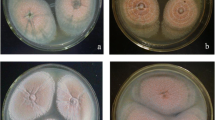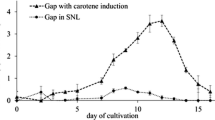Summary
Scanning and transmission electron microscopy of Cunninghamella blakesleeana grown in the presence of toxic concentrations of copper and cobalt indicated that copper, but not cobalt, induced both morphological and ultrastructural changes. In contrast to the control or cobalt-grown cultures, the hyphae of copper-grown cultures (called “blue mycelia”) were larger in diameter, had a rough and granular surface, and the cell wall was thicker. The cytoplasm of the blue mycelia was also abnormal and was in a compressed state. X-Ray microprobe analysis indicated a lower content of magnesium and calcium in the blue mycelia and an elevated content of sulphur in both the blue and cobalt-grown mycelia. The protein composition of the cell walls of the blue mycelia, fractionated on a Sepharose-4B column saturated with copper, was different from that of control or cobalt-grown cultures, as shown by their amino acid composition. Hydroxyproline was present only in the cell wall proteins of the blue mycelia, citrulline and cystathionine were present only in the proteins of cobalt-grown cultures, and proline was absent in the cell wall protiens of the control cultures.
Similar content being viewed by others
References
Bartnicki-Garcia S (1968) Cell wall chemistry, morphogenesis and taxonomy of fungi. Annu Rev Microbiol 22:87–105
Bradford MM (1976) A rapid sensitive method for the quantitation of microgram quantities of protein utilizing the principle of protein dye binding. Anal Biochem 72:248–254
Campos-Takaki GM, Beakes GW, Dietrich SMC (1983) Electron microscopic X-ray microprobe and cytochemical study of isolated cell walls of mucoralean fungi. Trans Br Mycol Soc 80:536–541
Carl AK, Borrebaeck K, Lonnerdal B, Etzler ME (1981) Metal chelate affinity chromatography of the Dolichos biflorus seed lectin and its sub-units. FEBS Lett 130:194–195
Cutsem P van, Gillet C (1982) Activity coefficients and selectivity values of Cu2+, Zu2+ and Ca2+ ions adsorbed in the Nitella flexilis L. cell wall during triangular ion exchanges. J Expt Bot 33:847–853
Galun M, Keller P, Malki D, Feldstein H, Galun E, Siegel SM, Siegel BZ (1983) Removal of uranium VI from solution by fungal biomass and fungal wall-related biopolymers. Science 219:285–286
Garcia-toledo A, Babich H, Stotzky G (1985) Training of Rhizopus stolonifer and Cunninghamella blakesleeana to copper: cotolerance to cadmium, cobalt, nickel, and lead. Can J Microbiol 31:485–492
Hippe S, Giesen U (1988) The effect of triadimenol on the cytology and growth of sensitive and resistant strains of Ustilago avenae. Ann Appl Biol 112:79–90
Lamport DTA (1970) Cell wall metabolism. Annu Rev Plant Physiol 21:235–270
Lyr H, Casperson G (1982) Anomalous cell wall synthesis in Mucor mucedo (L.) Fres. induced by some fungicides and other compounds related to the problem of dimorphism. Zeitschr Allg Mikrobiol 22:245–254
Motohiro F, Sunao Y, Shozo T (1983) Distribution of copper in the cells of the heavy metal tolerant fungus, Penicillium ochro-chloron, cultured in concentrated copper medium. Agric Biol Chem 47:1367–1369
Novaes-Ledieu M, Jimenez-Martinez A, Villanueva JR (1967) Chemical composition of hyphal wall of Phycomycetes. J Gen Microbiol 47:237–245
Pao VM, Aronson JM (1970) Cell wall structure of Sapromyces elongatus. Mycologia 62:531–541
Ramaiah A, Shanmugasundaram ERB (1962) Effect of molybdenum toxicity on sulfur metabolism in Neurospora crassa. Biochim Biophys Acta 60:373–385
Sietsma JH, Wessels JGH (1979) Evidence for covalent link-ages between chitin and d-glucan in a fungal cell wall. J Gen Microbiol 114:99–108
Stagg CM, Feather MS (1973) The characterization of chitin associated d-glucan from the cell walls of Aspergillus niger. Biochim Biophys Acta 320:64–72
Stuart DA, Varner JE (1980) Purification and characterization of a salt-extractable hydroxyproline-rich glycoprotein from aerated carrot discs. Plant Physiol 66:787–792
Subramanyam C, Gupta PD (1986) Glycogen deposition in Neurospora crassa under conditions of copper toxicity; a correlative ultrastructural and biochemical study. Microbios 45:55–62
Subramanyam C, Venkateswerlu G (1979) The effect of copper on histidine biosynthesis in Neurospora crassa. J Biosci (Bangalore) 1:143–149
Subramanyam C, Venkateswerlu G, Rao SLN (1983) Accumulation of histidinol phosphate in copper toxic cultures of Neurospora crassa. Curr Sci 52:879–880
Venkateswerlu G, Stotzky G (1986) Copper and cobalt alter the cell wall composition of Cunninghamella blakesleeana. Can J Microbiol 32:654–662
Author information
Authors and Affiliations
Rights and permissions
About this article
Cite this article
Venkateswerlu, G., Yoder, M.J. & Stotzky, G. Morphological, ultrastructural, and chemical changes induced in Cunninghamella blakesleeana by copper and cobalt. Appl Microbiol Biotechnol 31, 204–210 (1989). https://doi.org/10.1007/BF00262464
Received:
Accepted:
Issue Date:
DOI: https://doi.org/10.1007/BF00262464




